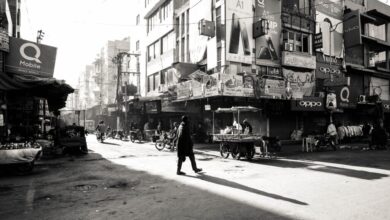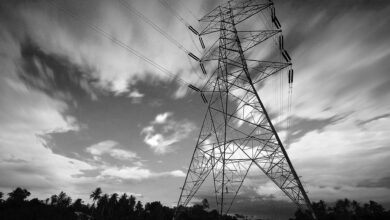ABCs of Pakistan
Through our series on the ABCs of Pakistan, we aimed to provide a very basic understanding of what the country is about. Macro Pakistani highlights:
- All you need to know about the economy
- Bite sized, digestible pieces
- Curated to cut through the noise
The current broad understanding we have provided, is a good start for anyone interested in Pakistan’s economy. The aim is to ensure we incorporate contemporary news and dive deeper into select topics of interest. Below we will summarize what we have learned so far.
All you need to know
We have mentioned repeatedly how one of the major issues with Pakistan’s economy is low investment and productivity growth. Hence, for anyone aiming to understand the Pakistani economy, that is where he or she should start. Economic growth is driven by growth in labor, capital or total factor productivity (TFP). TFP can be interpreted as how smartly factors of labor and capital are used and is the main determinant of long-term economic growth. Incidentally, in economic models, ‘A’ also denotes Total Factor Productivity.
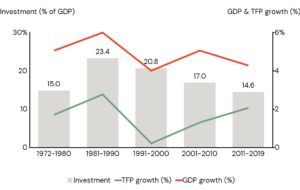
Source: Pakistan Institute of Development Economics (Working Paper 2020:11)
Pakistan experienced its highest decadal growth in the 1980s and that was also when investment levels were at the highest and consequently TFP was growing fastest too. According to PIDE, over 66% of Pakistan’s growth in the last 50 years has come about due to an increase in labor and capital inputs. This means, most growth has come about through an increase in resources (e.g. increased labor force) rather than making those resources more efficient.
The World Economic Forum considers TFP growth to be the best predictor of cross-country variations in living standards. Hence, it bases its Global Competitiveness Index 4.0 on the drivers of TFP. As mentioned before, Pakistan has had low export growth and been forced to go back to the IMF for support repeatedly. A comparison based on the index, shows broadly why its goods and services have become uncompetitive in international markets.

Source: Global Competitiveness Report 2019, World Economic Forum
Bite sized, digestible pieces
To make this comparison easier to understand, instead of comparing to all the other countries mentioned above, let’s benchmark Pakistan against Bangladesh. Institutions and infrastructure are poor across both low-middle income countries but where Bangladesh stands out is in its higher focus on ICT adoption, health and skills. It invested in its people and developed its human capital base to compete against the rest of the world. In Pakistan’s case, as we learned in an earlier post, a higher proportion of GDP is spent on the military as compared to health and education, as part of the annual budget.
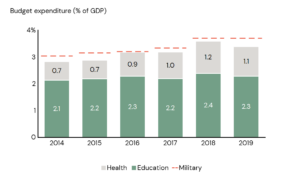
Source: Economic Survey of Pakistan 2019-20; Budget in Briefs (2014-21); MP Analysis
The first part of the ABCs of Pakistan highlighted the main structural issues. The second part, ‘B’, should show what our government plans to do about those issues. As Budget figures show, Pakistan has not only failed to prioritize investment in human development, it has also tried its best to understate military expenditures. While officially reported defense spending was 3% of GDP in 2019, military pensions, which make up an additional 0.7% of GDP, were reported under the civilian head.
Curated to cut through the noise
Mainstream media is noisy. If they try hard, audiences might be able to decipher the ‘what’ of a news story. The ‘so what’ however, is mostly missing. Even if we know the problems of Pakistan and what public officials are prioritizing, the reasoning behind is more often than not hard to find. At Macro Pakistani, we use in-depth data analysis and global benchmarks to clarify the ‘so what’. For example, most have heard of the Naya Pakistan Housing scheme. Some might even know that successive governments have tried to address the lack of low-income housing in Pakistan. In completing the ABCs of Pakistan, we will talk about the impact issues like housing have had on Consumers in Pakistan.
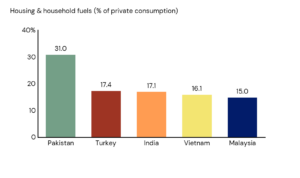
As Macro Pakistani has discussed before, consumers in Pakistan have to spend an outsized amount on housing and electricity in the country. Pakistan is a consumption driven economy and one of the biggest items private consumers spend on, is housing & household fuels. Because of failure of past governments in addressing issues with housing and energy, consumers in Pakistan have to spend almost twice as much as those in other countries. If you consume more, you save less of your income. If you save less, you invest less. That is how the cycle of low investment, low productivity, low income and lower standard of living perpetuates.
Macro Pakistani’s long-term aim is to democratize information in Pakistan and ensure the high levels of civic engagement in the country are channeled toward a greater sense of responsibility and accountability. We hope you join us in our journey to ensure a better future for Pakistan. If you would like to personally contribute content, please do get in touch!
Read the full article in the link below
ABCs of Pakistan: Bite sized summary of the Pakistani economy
Key highlights of the ABCs of Pakistan that will help digest the complex macroeconomics of the country through bite-sized pieces.



